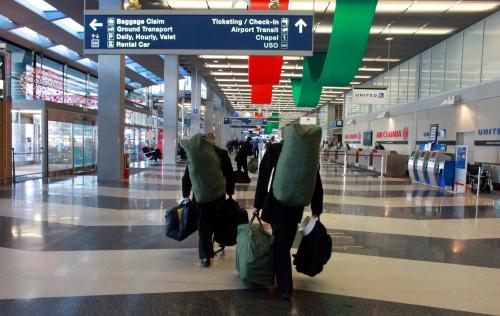Introduction
In a 1995 book, The Evolution of the Airline Industry, Steven A. Morrison and I assessed the effects of various hypothetical changes in airline competition on air travelers’ fares. An extreme scenario that we considered was that Alaska, Continental, America West, Northwest, TWA, and USAir exited the industry, leaving Southwest, United, American, and Delta as the only major carriers in the U.S. domestic market. At the time, we thought this large scale exit would be a tremendous shock to industry competition—note, we did not assume that the carriers exited by merging with other carriers. We found, however, that fares increased modestly, about 8 percent, which preserved most of the decline in fares due to deregulation. We attributed our finding to the ability of Southwest to enter additional markets and discipline fares.
Today, this extreme scenario no longer seems so extreme because if American’s proposed merger with US Airways is approved, then, with the exception of Alaska, all the carriers that we assumed would exit the industry would have done so. My testimony provides some perspective on this scenario, indicates why its effects on fares would differ from the prediction that we reported in our book, and assesses U.S. airlines’ merger activity in the broader context of the industry’s eventual evolution to a highly competitive, global airline industry.
The Scenario and Reality
The scenario we posited in our book differs from an actual post American-US Airways merger environment because we assumed that carriers would simply exit the industry and would not merge and because we accounted for competition among only four remaining carriers.
In our scenario, when a carrier was assumed to exit a market, all of its assets exited with it. This assumption ignored the potential benefits of a merger and overstated the exiting carrier’s effect in raising fares because its assets could have been put to more effective use if that carrier merged with another carrier, thereby creating a more efficient competitor. Indeed, retrospective empirical assessments of airline mergers have generally found that the presence of a merged air carrier in a market does not lead to higher fares. At the same time, travelers benefit from the merged carrier’s more extensive network and from more opportunities to use frequent flier miles.
Our scenario also did not account for the fact that in addition to American, Delta, United, and Southwest, the carriers that would still compete in the industry include Alaska, JetBlue, Spirit, Frontier, Virgin America, Allegiant, and Hawaiian Air among others.
Accordingly, even though for the last decade or so the U.S. airline industry has been evolving in a way that is consistent with the extreme scenario in our book, as shown in Borenstein and Rose’s recent paper reporting U.S. airline industry operating characteristics through 2011, real yields have continued to decline since deregulation in 1978; real yields have been consistently below the Standard Industry Fare Level (SIFL) that was used by the Civil Aeronautics Board to determine regulated fares; low-cost carriers’ market share has steadily increased; route level concentration on hub and non-hub routes has stabilized during the past ten years; and the industry average load factor (the percentage of seats filled by paying passengers) has steadily increased. And, as reported in Tomer, Puentes, and Neal’s Brookings study, travel in U.S. international markets has more than doubled between 1990 and 2011 as U.S. carriers have taken advantage of open skies agreements to expand their international networks and increase flight frequency.
Similar to the mergers that preceded it, the merger of American Airlines and US Airways would preserve those positive long run trends. Carrier competition would continue to be intense and low-cost carriers would continue to put downward pressure on fares. Entry and exit would continue to be fluid in airline markets as a merged American and US Airways would optimize its network by exiting some routes and entering others, while other carriers would adjust their networks by entering some of the routes that American exited and exiting some of the routes that they entered. The merged American and US Airways would also strengthen its international network and benefit travelers by serving more foreign destinations.
In retrospect, the extreme scenario depicted in our book previewed a natural evolution of the industry in response to deregulation with the critical caveat that instead of completely exiting the industry, certain carriers have merged with others, which has enabled the industry’s capital stock to become more productive as, for example, merged carriers have been able to retire their least efficient aircraft more quickly and has enabled the merged carriers to strengthen their international networks.
Toward a Global Airline Industry
A proposed merger between large firms is often accompanied by concerns that the consolidation would reduce competition and raise prices. If policymakers are concerned that the proposed American-US Airways merger may have anti-competitive effects, notwithstanding any gains in operating efficiency, then an effective way to address those concerns, obtain the efficiency gains, and significantly benefit travelers would be to take steps to stimulate additional competition by creating a deregulated global airline industry.
In fact, U.S. and foreign policymakers have already begun that process by negotiating open skies agreements, which give U.S. and foreign carriers the freedom to enter and set fares in U.S. international markets. As expected, air travelers have benefited. In a recent paper, Jia Yan and I estimated that the reduction in fares and increase in flight frequencies in markets that are governed by open skies agreements has raised travelers’ welfare $5 billion annually. If the United States negotiated agreements with foreign countries so that all U.S. international routes were governed by open skies, we estimate that travelers would gain an additional $5 billion annually.
The final step to create a highly competitive global airline industry would be for the United States to allow foreign airlines to serve U.S. domestic markets. (Other countries should also allow foreign carriers, including U.S. carriers, to serve their domestic markets.) Clearly, competition would be even more intense in U.S. markets and travelers would benefit from lower fares and service improvements if their choice of carriers were expanded to include discount carriers like Ryanair and global players like Qantas and British Airways. Such airlines have never posed a threat to national security or to the safety of air travelers.
Whether it was part of their grand design, U.S. carriers have been preparing for decades for a truly competitive global airline industry. As part of this process, they decided that mergers would help them develop more efficient operations and networks. No evidence exists to question the effectiveness of that strategy; hence, policymakers have been wise to allow consolidation to move forward and they should allow American Airlines and US Airways to continue the process. Policymakers should also accelerate the airline industry’s contribution to globalization by creating a truly competitive deregulated environment that would benefit travelers in the United States and throughout the world.







Commentary
TestimonyThe American Airlines-US Airways Merger in an Evolving Airline Industry
February 26, 2013